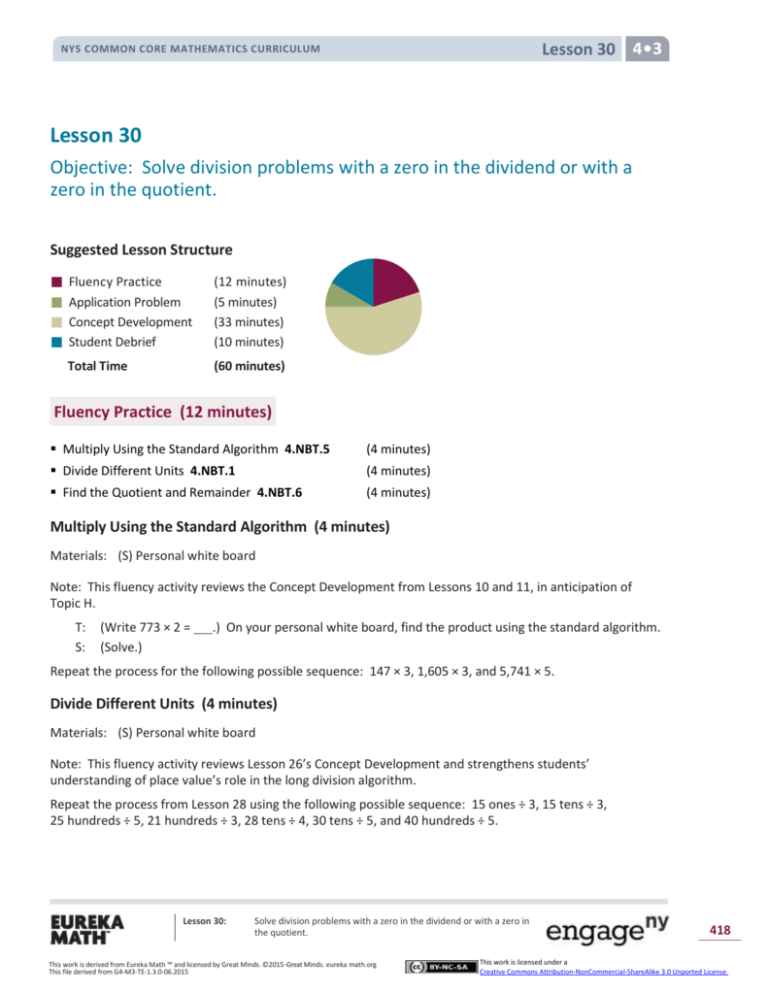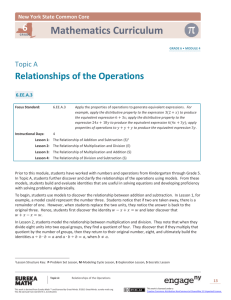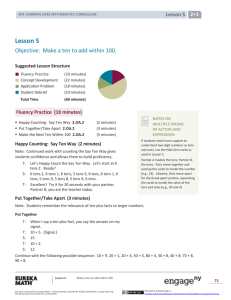Grade 4 Mathematics Module 3, Topic G, Lesson 30
advertisement

Lesson 30 NYS COMMON CORE MATHEMATICS CURRICULUM Lesson 30 Objective: Solve division problems with a zero in the dividend or with a zero in the quotient. Suggested Lesson Structure Fluency Practice Application Problem Concept Development Student Debrief Total Time (12 minutes) (5 minutes) (33 minutes) (10 minutes) (60 minutes) Fluency Practice (12 minutes) Multiply Using the Standard Algorithm 4.NBT.5 (4 minutes) Divide Different Units 4.NBT.1 (4 minutes) Find the Quotient and Remainder 4.NBT.6 (4 minutes) Multiply Using the Standard Algorithm (4 minutes) Materials: (S) Personal white board Note: This fluency activity reviews the Concept Development from Lessons 10 and 11, in anticipation of Topic H. T: S: (Write 773 × 2 = (Solve.) .) On your personal white board, find the product using the standard algorithm. Repeat the process for the following possible sequence: 147 × 3, 1,605 × 3, and 5,741 × 5. Divide Different Units (4 minutes) Materials: (S) Personal white board Note: This fluency activity reviews Lesson 26’s Concept Development and strengthens students’ understanding of place value’s role in the long division algorithm. Repeat the process from Lesson 28 using the following possible sequence: 15 ones ÷ 3, 15 tens ÷ 3, 25 hundreds ÷ 5, 21 hundreds ÷ 3, 28 tens ÷ 4, 30 tens ÷ 5, and 40 hundreds ÷ 5. Lesson 30: Solve division problems with a zero in the dividend or with a zero in the quotient. This work is derived from Eureka Math ™ and licensed by Great Minds. ©2015 -Great Minds. eureka math.org This file derived from G4-M3-TE-1.3.0-06.2015 418 This work is licensed under a Creative Commons Attribution-NonCommercial-ShareAlike 3.0 Unported License. Lesson 30 NYS COMMON CORE MATHEMATICS CURRICULUM Find the Quotient and Remainder (4 minutes) Materials: (S) Personal white board Note: This fluency activity reviews Lesson 29’s Concept Development. T: S: (Write 4,768 ÷ 2.) On your personal white board, find the quotient and remainder. (Solve.) Continue with the following possible sequence: 6,851 ÷ 5, 1,264 ÷ 4, and 1,375 ÷ 4. Application Problem (5 minutes) The store wanted to put 1,455 bottles of juice into packs of 4. How many complete packs can they make? How many more bottles do they need to make another pack? Note: This problem is a review of Lesson 29, which bridges dividing with remainders to the current lesson. Concept Development (33 minutes) Materials: (S) Personal white board Problem 1: Divide with a zero in the dividend. 804 ÷ 4 T: S: T: S: T: S: What is our first step to divide 804 by 4? Divide the hundreds place. Divide the largest units by 4. 8 hundreds divided by 4 is…? 2 hundreds. Say a multiplication sentence that tells how many hundreds have been distributed, starting with 2 hundreds. 2 hundreds times 4 equals 8 hundreds. Lesson 30: NOTES ON MULTIPLE MEANS OF REPRESENTATION: Build understanding of long division by showing 804 divided by 4 with place value disks, base ten blocks, or real objects such as money. If beneficial, try the following: Use color to record the partial dividends (e.g., 8 hundreds). Draw arrows to the numbers that are brought down when remainders are regrouped with smaller units from the whole. Encourage students to ask questions for clarity as they work. Solve division problems with a zero in the dividend or with a zero in the quotient. This work is derived from Eureka Math ™ and licensed by Great Minds. ©2015 -Great Minds. eureka math.org This file derived from G4-M3-TE-1.3.0-06.2015 419 This work is licensed under a Creative Commons Attribution-NonCommercial-ShareAlike 3.0 Unported License. Lesson 30 NYS COMMON CORE MATHEMATICS CURRICULUM T: S: T: S: T: S: T: MP.8 S: T: S: T: S: T: S: T: S: T: S: Tell your partner how to find how many hundreds remain. 8 hundreds minus 8 hundreds is 0 hundreds. Zero hundreds remain. Zero hundreds remain. If zero hundreds remain, we can’t decompose hundreds into tens to keep dividing. Are we finished? If there are no more hundreds to regroup as tens, I guess we are finished. Even if we had hundreds to regroup, there aren’t any tens to regroup with. There are still 4 ones. We have to divide those. Can we move straight to dividing in the ones column? Discuss with your partner what happens if we just pass by the tens since there are zero tens. We have to divide all of the units in the whole, so yeah, let’s divide 4 ones by 4. If we do that, we record 1 one in the ones column, but then we have nothing to record in the tens column because we skipped it. Our answer could be 21. But if I multiply 21 times 4, that’s 84, and the whole is 804. We have to keep dividing in the tens, even if there are zero tens to divide, otherwise our answer will be wrong. Yes, we must keep dividing unit by unit, even if there is a zero in a unit. Zero hundreds renamed as tens is zero tens. Zero tens plus zero tens is zero tens. What is zero tens divided by 4? Zero tens. We continue recording even if we have zero tens to regroup. Zero tens times 4 is…? Zero tens. Zero tens minus zero tens is zero tens. 4 ones remain. Work with your partner to find the quotient. (Continue dividing until they reach the quotient of 201.) Say the complete equation. 804 divided by 4 equals 201. Check your work using multiplication. 201 times 4 equals 804. Tell your partner how you know when to stop dividing. When there are no more remainders, you are finished. You must keep dividing in each place value, even if there are zero remainders or a zero in the whole. Keep dividing until each place value has been divided. Once you divide the ones, you have a quotient and possibly a remainder. You must keep dividing the smaller units even if you don’t have any larger units to divide. Lesson 30: Solve division problems with a zero in the dividend or with a zero in the quotient. This work is derived from Eureka Math ™ and licensed by Great Minds. ©2015 -Great Minds. eureka math.org This file derived from G4-M3-TE-1.3.0-06.2015 420 This work is licensed under a Creative Commons Attribution-NonCommercial-ShareAlike 3.0 Unported License. Lesson 30 NYS COMMON CORE MATHEMATICS CURRICULUM Problem 2: Divide with a zero in the quotient. 4,218 ÷ 3 T: Work with your partner to divide the thousands and the hundreds. As I circulate around the room, let me hear you using the language of units as you divide. Allow students one to two minutes to divide. Have two students come to the board to show their work. T: S: T: S: T: S: I see that these students have found the quotient contains 1 thousand and 4 hundreds. When they subtracted the distributed hundreds, there was no remainder. We don’t need to rename zero hundreds as tens, but we do have 1 ten to divide. Discuss with your partner your next steps. 1 ten cannot be divided by 3. I’m not sure what to do. But 10 divided by 3 would give me a quotient of 3. But that’s 3 ones, not 3 tens. If I divided 1 ten into 3 groups, I would distribute zero tens if I was using disks, so the answer is zero tens. We should record zero tens in our quotient. Right! If we distribute zero tens we record zero in the quotient and still have 1 ten and 8 ones remaining. Talk with your partner about your next steps. We can change 1 ten for 10 ones. Now we have 18 ones divided by 3 is 6 ones. Our quotient is 1,406. Talk with your partner about the importance of the zero in your quotient. If I didn’t record the zero, my answer would be wrong. The zero is a placeholder of the tens. I can’t leave that place empty. Or, what if I tried recording the 6 ones in the tens place? Then, my answer would really be wrong! I can always use multiplication or estimation to check my work in case I may have recorded wrong. Problem Set (20 minutes) Students should do their personal best to complete the Problem Set within the allotted 20 minutes. For some classes, it may be appropriate to modify the assignment by specifying which problems they work on first. Some problems do not specify a method for solving. Students should solve these problems using the RDW approach used for Application Problems. Lesson 30: NOTES ON MULTIPLE MEANS OF ENGAGEMENT: Students working above grade level will enjoy the challenge of Problem 11(b) on the Problem Set. Extend the problem further by asking, “How could you change the whole so that there is a zero in the quotient in a different place (than the hundreds place)?” Solve division problems with a zero in the dividend or with a zero in the quotient. This work is derived from Eureka Math ™ and licensed by Great Minds. ©2015 -Great Minds. eureka math.org This file derived from G4-M3-TE-1.3.0-06.2015 421 This work is licensed under a Creative Commons Attribution-NonCommercial-ShareAlike 3.0 Unported License. Lesson 30 NYS COMMON CORE MATHEMATICS CURRICULUM Student Debrief (10 minutes) Lesson Objective: Solve division problems with a zero in the dividend or with a zero in the quotient. The Student Debrief is intended to invite reflection and active processing of the total lesson experience. Invite students to review their solutions for the Problem Set. They should check work by comparing answers with a partner before going over answers as a class. Look for misconceptions or misunderstandings that can be addressed in the Debrief. Guide students in a conversation to debrief the Problem Set and process the lesson. Any combination of the questions below may be used to lead the discussion. In Problem 6, did anyone get 128? How did you know that was wrong? In Problem 10, the whole had consecutive zeros. How does your place value knowledge help you to keep track of where you are dividing? How does multiplication help you check your division? For what reason might there be a zero in the quotient? We divide, starting with the largest unit, and see if there is a remainder. What do we do with the remaining unit or units? How is that different than what we do in the ones place? Normally, we stop dividing at the ones place, and if there’s a remainder, we give the remainder with the quotient. What if we were dividing up money? If we got down to the ones place, using dollars, what could we do? Exit Ticket (3 minutes) After the Student Debrief, instruct students to complete the Exit Ticket. A review of their work will help with assessing students’ understanding of the concepts that were presented in today’s lesson and planning more effectively for future lessons. The questions may be read aloud to the students. Lesson 30: Solve division problems with a zero in the dividend or with a zero in the quotient. This work is derived from Eureka Math ™ and licensed by Great Minds. ©2015 -Great Minds. eureka math.org This file derived from G4-M3-TE-1.3.0-06.2015 422 This work is licensed under a Creative Commons Attribution-NonCommercial-ShareAlike 3.0 Unported License. Lesson 30 Problem Set NYS COMMON CORE MATHEMATICS CURRICULUM Name Date Divide. Check your solutions by multiplying. 1. 204 ÷ 4 2. 704 ÷ 3 3. 627 ÷ 3 4. 407 ÷ 2 Lesson 30: Solve division problems with a zero in the dividend or with a zero in the quotient. This work is derived from Eureka Math ™ and licensed by Great Minds. ©2015 -Great Minds. eureka math.org This file derived from G4-M3-TE-1.3.0-06.2015 423 This work is licensed under a Creative Commons Attribution-NonCommercial-ShareAlike 3.0 Unported License. Lesson 30 Problem Set NYS COMMON CORE MATHEMATICS CURRICULUM 5. 760 ÷ 4 6. 5,120 ÷ 4 7. 3,070 ÷ 5 8. 6,706 ÷ 5 Lesson 30: Solve division problems with a zero in the dividend or with a zero in the quotient. This work is derived from Eureka Math ™ and licensed by Great Minds. ©2015 -Great Minds. eureka math.org This file derived from G4-M3-TE-1.3.0-06.2015 424 This work is licensed under a Creative Commons Attribution-NonCommercial-ShareAlike 3.0 Unported License. Lesson 30 Problem Set NYS COMMON CORE MATHEMATICS CURRICULUM 9. 8,313 ÷ 4 10. 9,008 ÷ 3 11. a. Find the quotient and remainder for 3,131 ÷ 3. b. How could you change the digit in the ones place of the whole so that there would be no remainder? Explain how you determined your answer. Lesson 30: Solve division problems with a zero in the dividend or with a zero in the quotient. This work is derived from Eureka Math ™ and licensed by Great Minds. ©2015 -Great Minds. eureka math.org This file derived from G4-M3-TE-1.3.0-06.2015 425 This work is licensed under a Creative Commons Attribution-NonCommercial-ShareAlike 3.0 Unported License. E Lesson 30 Exit Ticket NYS COMMON CORE MATHEMATICS CURRICULUM Name Date Divide. Check your solutions by multiplying. 1. 380 ÷ 4 2. Lesson 30: 7,040 ÷ 3 Solve division problems with a zero in the dividend or with a zero in the quotient. This work is derived from Eureka Math ™ and licensed by Great Minds. ©2015 -Great Minds. eureka math.org This file derived from G4-M3-TE-1.3.0-06.2015 426 This work is licensed under a Creative Commons Attribution-NonCommercial-ShareAlike 3.0 Unported License. Lesson 30 Homework NYS COMMON CORE MATHEMATICS CURRICULUM Name Date Divide. Check your solutions by multiplying. 1. 409 ÷ 5 2. 503 ÷ 2 3. 831 ÷ 4 4. 602 ÷ 3 Lesson 30: Solve division problems with a zero in the dividend or with a zero in the quotient. This work is derived from Eureka Math ™ and licensed by Great Minds. ©2015 -Great Minds. eureka math.org This file derived from G4-M3-TE-1.3.0-06.2015 427 This work is licensed under a Creative Commons Attribution-NonCommercial-ShareAlike 3.0 Unported License. Lesson 30 Homework NYS COMMON CORE MATHEMATICS CURRICULUM 5. 720 ÷ 3 6. 6,250 ÷ 5 7. 2,060 ÷ 5 8. 9,031 ÷ 2 Lesson 30: Solve division problems with a zero in the dividend or with a zero in the quotient. This work is derived from Eureka Math ™ and licensed by Great Minds. ©2015 -Great Minds. eureka math.org This file derived from G4-M3-TE-1.3.0-06.2015 428 This work is licensed under a Creative Commons Attribution-NonCommercial-ShareAlike 3.0 Unported License. Lesson 30 Homework NYS COMMON CORE MATHEMATICS CURRICULUM 9. 6,218 ÷ 4 10. 8,000 ÷ 4 Lesson 30: Solve division problems with a zero in the dividend or with a zero in the quotient. This work is derived from Eureka Math ™ and licensed by Great Minds. ©2015 -Great Minds. eureka math.org This file derived from G4-M3-TE-1.3.0-06.2015 429 This work is licensed under a Creative Commons Attribution-NonCommercial-ShareAlike 3.0 Unported License.









